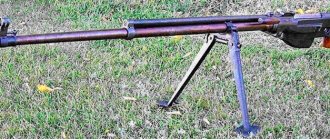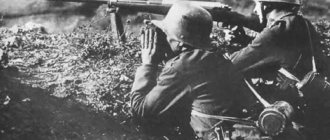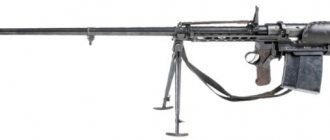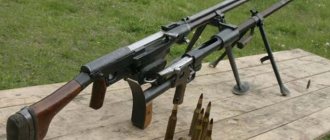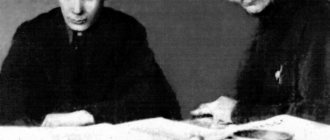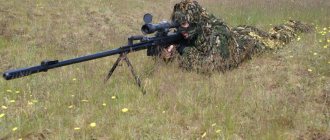Simonov anti-tank rifle mod. 1941 or PTRS is a Soviet hand-held, self-loading small arms designed to combat enemy armored vehicles (light and medium tanks, armored vehicles). It can be used against low-flying air targets at a distance of up to 500 meters, as well as against defensive fortifications such as bunkers and bunkers covered with armor.
Simonov PTRS anti-tank rifle
Characteristics
Normal combat requirements for PTRD:
- three or four holes out of four fit into a circle with a diameter of 22 cm;
- the average point of impact deviates from the control point by no more than 7 cm vertically and no more than 5 cm horizontally.
The battle is checked by firing single shots at a black rectangle 30 cm high and 20 cm wide, mounted on a white shield 1 m high and 1 m wide. Firing range - 100 m, position - prone from a bipod, cartridges - B-32.
Armor penetration, mm:
- at 300 m - 35,
- at 100 m - 40.
Indicators of bullet dispersion when firing from a PTRD reduced to normal combat:
| Firing range, m | Core stripes in height, cm | Core stripes width, cm |
| 100 | 21 | |
| 200 | 42 | 36 |
| 300 | 63 | 55 |
| 400 | 84 | 73 |
| 500 | 105 | 92 |
Where the core stripe is the scattering stripe, containing 70% of the hits.
Loading and firing a shot
To load the PTRD, you must perform the following steps:
- turn the bolt handle to the left (the barrel channel is unlocked);
- pull the bolt back all the way (the bolt stop rests against the rear plane of the left lug of the bolt and holds it in the receiver);
- place the cartridge on the guide bevel of the upper window of the receiver and send it into the chamber;
- send the bolt forward (the bolt moves the cartridge into the chamber, and the firing pin cocking, hitting the sear of the trigger mechanism, stops the firing pin, keeping it cocked);
- turn the bolt handle to the right until it stops (the barrel bore is locked, the mainspring receives the greatest tension, the ejector hook slides into the sharpening of the case head, the reflector is recessed into its socket with the case head).
After this, to fire a shot you only need to press the tail of the trigger. Wherein:
- The trigger rotates the trigger lever, causing the sear to drop and come out from under the firing pin.
- The mainspring, expanding, presses on the firing pin coupling and forcefully sends the firing pin forward with the firing pin, breaking the cartridge primer.
- The barrel with the receiver and trigger boxes and the bolt move back under the pressure of the powder gases to the bottom of the sleeve, which causes the shock absorber spring to compress. The shutter handle, having reached the curved edge of the tide of the outer tube, begins to slide along it and turn to the left. The lugs of the bolt extend from behind the supporting lugs of the receiver and stand against the longitudinal grooves. The bolt, moving backward by inertia, is separated from the rear edge of the barrel, and the ejector hook removes the cartridge case from the chamber. When the cartridge case stands against the lower window of the receiver, the reflector pushes it out from under the ejector hook.
- The bolt stops in the rear position, hitting the bolt stop with the left lug.
- The shock absorber spring returns the moving parts to their most forward position.
To set the hammer to the safety cock, you need to pull the firing pin hook back as far as it will go and turn it to the right.
Operating countries
- USSR
- Germany - captured PTRDs were used by the Wehrmacht under the name Panzerbüchse 783(r)
- Czechoslovakia - in service with the 1st Czechoslovak Army Corps
- Poland - in 1943, the PTRD was received by the 1st Polish anti-tank company of the 1st Polish Infantry Division named after T. Kosciuszko, and later by other Polish units
- Bulgaria - in 1944-1945. The USSR transferred 300 anti-tank rifles (PTRD and PTRS) to the Bulgarian army, which were used during combat operations
- China
- DPRK
- DPR - is in service with a number of DPR units and has been used in combat since 2014 in the Slavyansk region
- Ukraine - in 2014-2015. Ukrainian army units used PTRDs with optical sights to fire at armored vehicles.
PTRD in culture
There are references to PTRD and its use in many works: including literary works, films, cartoons and computer games.
The goal is not only tanks
The high tactical and technical characteristics of anti-tank rifles made it possible to use them until the last days of the war. Armor-piercing crews easily dealt with enemy vehicles, low-flying aircraft, self-propelled guns and armored personnel carriers. In addition, anti-tank rifles were effectively used to fire at concrete fortifications (pillboxes) and guns.
Crew of the Soviet anti-tank rifle PTRD-41 in position during the Battle of Moscow. Moscow region, winter 1941-1942.
Service
Partial disassembly is carried out for cleaning and lubrication in the following order:
- the gun is placed on a bipod;
- the shutter is removed;
- the shutter is disassembled.
Reassembly after partial disassembly is carried out in the reverse order.
Complete disassembly is carried out for cleaning in case of heavy contamination and for repair in the following order:
- incomplete disassembly is performed;
- bipods are separated;
- the butt is separated;
- the trigger mechanism is disassembled;
- The bolt stop is separated.
Reassembly after complete disassembly is carried out in the reverse order.
When lubricating the gun you must use:
- in summer - gun lubricant,
- in winter (at temperatures down to −30 °C) - winter gun lubricant,
- in winter (at temperatures below −30 °C) - grease No. 21,
- when the gun is in storage without being used, use special gun lubricant.
In computer games
- In addition to Call of Duty, United Offensive, PTRS-41 anti-tank rifles are often found. They are presented in the form of stationary weapons.
- The PTRS-41 anti-tank rifle appears in Call of Duty 5: World at War. It can be used to destroy enemy armored vehicles, and in the last mission it has an optical sight, which allows it to be used as a sniper rifle. Appears in the levels "Vendetta", "Heart of the Reich" and "Collapse". In multiplayer it is the most powerful rifle.
- The Grizzly anti-tank rifle is found in the game Unturned.
- In the game Heroes & Generals, playing for the Soviet faction, you can unlock the PTR of the Degtyarev system (PTRD).
- In the game Battlefield 1 there is an anti-tank rifle Tankgewehr M1918
- Battlefield 2142 features the Pilum, a portable anti-tank rifle for taking out medium and heavily armored targets.
Design
Wehrmacht soldier with captured PTRD, November 1941
The barrel has a channel with eight rifling, curling from left to top to right, a muzzle brake to reduce recoil, in the middle there is a handle for carrying the weapon and a groove for attaching a bipod. At the front of the barrel there is a front sight base (on which the front sight is mounted), and at the rear there is a sight bracket.
On the left side of the receiver there is a bolt stop, and on the bottom there is a trigger mechanism. On the outside, the receiver has: an upper window (for inserting a cartridge), a lower window (for ejecting a spent cartridge case), a platform with a protrusion (for connecting to the butt), a cutout (for moving the bolt handle when locking and unlocking the barrel bore). Inside the receiver has: a channel for placing the bolt, two longitudinal grooves and two supporting protrusions.
The trigger mechanism consists of a trigger, a trigger lever, a sear and two springs (for the sear and the trigger lever).
The sight consists of a bracket, a rear sight with a slot and a spring. In early samples, the bracket has a hole through which the rear sight moves up and down. In the lower position, the rear sight corresponds to firing distances of up to 400 m, and in the upper position - from 400 m to 1000 m. In the later position, the rear sight rotates on its axis by 90°, also having two positions for shooting at distances up to 400 m and from 400 m to 1000 m.
The front sight is pushed into the groove of the front sight base and can move left and right when the PTRD is brought to normal combat.
The bolt consists of a bolt frame and a firing mechanism. The bolt body has: a handle, a cup with a rim (for placing the cartridge head), a channel (for the passage of the firing pin), a groove (for placing the ejector), a socket (for the reflector and its spring), two lugs (for locking the barrel), beveled a cutout (retracting the firing pin when the bolt is opened), an annular groove (into which the annular protrusion of the coupling fits to engage the striking mechanism with the bolt frame) and two holes (discharging powder gases if they break through inside the bolt). The striker mechanism consists of a striker (having a protrusion with a firing pin), a connecting coupling (connecting the striker mechanism with the bolt), a mainspring (sending the striker to the forward position), a restrictive tube (limiting the retreat of the striker back), a striker coupling (protecting the striker from disengaging with striker) and striker (breaking the capsule).
The butt is attached to the receiver and consists of a shoulder rest (pillow) with an outer tube and a trigger box with an inner tube. The shock absorber spring is located in the outer tube, and on the left there is a stop for the gunner’s cheek. On the right there is a tide with a curved edge for opening the shutter after a shot. A wooden rest is attached to the pad and outer tube for holding with the left hand while shooting. The trigger box with an inner tube houses the trigger mechanism. A pistol grip is attached to the inner tube for ease of shooting. The trigger box has a platform for connecting the stock with the receiver, a hole for a pin (which secures the trigger box to the receiver) and a trigger guard (which protects against accidental pressing of the trigger).
Accessories for the PTRD: a composite cleaning rod, a wrench, a screwdriver, a double-neck oil can and a brush. Also for each gun there are two canvas cartridge bags (for 20 rounds each), two canvas covers (for the breech and muzzle of the gun) and a form (with the results of the battle check, the number of shots, delays and methods for eliminating them).
Features of use
Simonov's self-loading rifle was served by a crew of 2 people. It could be carried by two people in disassembled form (stock with receiver and bipod with barrel), or by one.
Instructions for fighters on PTRS Simonov
Structurally, it is more complex than Degtyarev’s gun, but at the same time it had a higher rate of fire (by 5 shots).
Until the end of 1941, only 77 weapons were manufactured. But the very next year, 63,308 PTRS units were produced, and before the end of World War II, a little more than 190,000 weapons were produced.
At the beginning of the war, the Germans noted the fact that this weapon was highly effective - it easily hit any armored vehicle and was far superior to its German counterparts. Considering the positive factors of the gun, the Wehrmacht decided to regularly strengthen the armor protection of its tanks and, in the end, the effectiveness of the PTRS decreased. At the same moment, the production of these weapons began to decline. Production finally ceased in January 1945.
Simonov anti-tank rifle
This is interesting: Simonov’s anti-tank rifle was actively used during the Korean War.
At the end of the war, anti-tank crews could no longer do much with enemy armored vehicles and they were quite often brought in to fight bunkers and enemy self-propelled guns.
Shooting and combat tactics
According to a person who shot from a gun, who is over 70 years old, it is not difficult to conduct aimed fire with it. Too much recoil, which leaves bruises and can break your collarbone, is a myth. During the shot, a unmasking effect occurs, as a fire cloud is formed, which is formed when passing the muzzle brake. In addition to the fiery cloud, the shooter's position is indicated by raised dust, wood chips, foliage, etc.
PTRD-41
had aimed shooting up to 1500 meters. Effective shooting depended on the chosen target; if the target was lightly armored, then shooting could be carried out from a distance of 1000 meters, at aircraft up to 500 meters, at bunkers with armor protection up to 800 meters. Regarding tanks, the shooting depended on what armor needed to be penetrated, so 45-50 mm of armor was penetrated at 100 meters. At a distance of 300 meters, 30-35 mm of armor. For firing from PTRS, 14.5x114 mm cartridges are used. The cartridge has a colossal shot energy of 30 kJ; for comparison, the 12.7x108 mm cartridge is 18 kJ. During the Second World War, the B-32 (armor-piercing incendiary with a hardened core) and BS-41 (armor-piercing incendiary with a tungsten carbide core, in everyday life this metal alloy is known as “win”, which is used in the manufacture of drills for hammer drills) were used. . It was recommended to fire at the side projections of the tanks, since the thickness of the armor made it possible to penetrate them with a PTRD. The defeat of armored vehicles occurred with armor-piercing cartridges made of hardened steel or Pobedit cartridges that had an incendiary filling or a substance called chloroacetophenone, which caused a portable presence in armored vehicles. Thus, the crew of the armored vehicle could be harmed by the armor-piercing core, which pierced the armor and a small number of fragments that scattered in different directions after penetration. Sometimes up to 10 penetrations were required to destroy a tank. In practice, in order to hit a tank, armor-piercing specialists allowed tanks to approach at 100 meters, and not at 300 meters as recommended in exercises and instructions on anti-tank guns. For this reason, armored vehicles called PTRDs and PTRS “fishing rods”, since PTRDs are long, and the enemy tank had to be brought closer - “hook”.
It is also worth comparing PTRD and PTRS
, since they were adopted in the first days of the war and went through all 4 years of the war side by side.
The PTRS
had advantages compared to the PTRD, such as an effective range of 1000 meters for the PTRD versus 1500 meters for
the PTRS
, and automatic reloading, but it was inferior in terms of reloading reliability and weight: 21 kg versus 17 kg for the PTRD.
The automatic PTRS
was not famous for its reliability, since the gun was made for a 14.5x114 mm cartridge, which had almost 30 kJ of power, and at that time the engineers who created weapons for this cartridge did not have practical experience in creating weapons for such a powerful automatic weapon.
In connection with this, the PTRS
sometimes had repeated shots, not full automatic cycles.
And the creation of automatic rifles took more labor and required more complex production operations. During the war, there were attempts to install an optical sight on the PTRS
, but it never worked out, since the recoil of the shot disrupted the optics settings.
In the photo in the article you can see PTRS
with a sight, which were installed in a makeshift manner in 2014-2015. According to some data, at a distance of 2400 meters you can hit a target the size of a car; at such a distance, hitting light armored vehicles is not effective.
The advantage of the “armor piercers” was that ordinary infantry troops could repel the enemy’s mechanized units and were mobile. Anti-tank rifles also provided a positive morale force, since they no longer fought against armored vehicles with their bare hands. There is an opinion that PTRD and PTRS
in December 1944 they were discontinued, as the tanks received thicker armor, which became too tough for anti-tank rifles.
As the author of the article, I do not agree with this data, since the enemy did not run out of medium and light tanks, and there were also many armored personnel carriers and armored cars. Pillboxes, planes, and machine gun crews also remained on the battlefield. And combat operations using PTRS
in urban conditions would have had a result, since the “armor-piercer” could fire a couple of aimed shots from any window into the side of even a medium tank and ruin its “hide.” Production was discontinued due to the fact that the troops already had sufficient quantities of anti-tank rifles, and the outcome of the war was already clear. Even at the end of the war with Japan, successful cases of using anti-tank rifles against Japanese medium tanks are known.
Results
Even after 70 years, PTRS and PTRD made their presence known during the military conflict in Ukraine (Donbass, 2015-2017), where they appeared in fairly large numbers from captured long-term storage warehouses. Anti-tank rifles have been successfully used against infantry fighting vehicles and armored personnel carriers shows their relevance, plus it is not difficult to find ammunition for these guns, since they are used for KPVT machine guns. The question of more interest is why, after the Second World War, the guns were handed over to army warehouses, and new anti-material rifles were not created, and only 60 years later they began to produce 12.7 mm rifles, while forgetting about 14.5 mm rifles. PTRS also participated during the Korean War in 1950-1953. Captured guns were adopted by the German army, where the gun served under the designation Panzerbüchse 784 (R). After the war, part of the PTRS was transferred to whaling ships for
.For those who are looking at the disadvantages (weight, automation, poor accuracy) in the PTRS , you can ask just one question: “What types of weapons of this caliber, or even smaller caliber, do you know that were created in less than 22 days?”
Technical characteristics of PTRS-41
| Number of shots | 5 rounds |
| Barrel caliber | 14.5x114mm |
| Combat rate of fire | 15 rounds per minute |
| Sighting range | 1500 meters |
| Maximum firing range | no data |
| Effective shooting | 800 meters |
| Initial departure speed | 1020 m/s |
| Automation | gas outlet, shutter misalignment |
| Weight | 20.9 kg+1.1 kg (cartridges) |
| Bullet energy | 29.8 kJ |
| Dimensions | 2108 mm |
Number of PTRD and PTRS produced
| Weapons factories | PTR type | 1941 | 1942 | 1943 | 1944 | Total |
| Plant No. 2 NKV Kovrov | PTRD | 16038 | 144959 | 78463 | 239460 | |
| Plant No. 74 NKV Izhevsk | PTRD | 1611 | 40040 | 41651 | ||
| PTRS | 2 | 29416 | 42521 | 19436 | 91375 | |
| Plant No. 614 NKV Saratov | PTRS | 75 | 35227 | 38346 | 13539 | 81187 |
| Plant No. 385 NKV Zlatoust | PTRD | 17726 | 5719 | 6334 | 12053 | |
| Total | 17726 | 249642 | 165049 | 39309 | 471726 | |
Notes
- ↑
- ↑ Manual on shooting. Anti-tank self-loading rifle mod. 1941 Simonov system - PTRS. Anti-tank single-shot rifle mod. 1941 Degtyarev system - PTRD (1941)
- ↑
- ↑ Ustinov, Dmitry Fedorovich.
In the name of Victory: Notes of the People's Commissar of Armaments. - M.: Military Publishing House, 1988. - P. 170-173. — 318 p. - (War memoirs). — ISBN 5-203-00568-0. - Weapons of Victory: / I. V. Bakh, I. I. Vernidub, L. I. Demkina and others; Under general ed. V. N. Novikova. — 2nd ed., revised. and additional.. - M.: Mashinostroenie, 1987. - P. 262. - 509 p.
- Botin, V.
Designer of small arms (to the 100th anniversary of the birth of V. A. Degtyarev) // “Military Historical Journal”. - 1980. - No. 1. - P. 94-96. - Shunkov, Viktor Nikolaevich.
Military and service weapons of Russia. - M.: Eksmo, 2012. - P. 451, 456. - 519 p. — ISBN 978-5-699-53557-6. - Portuguese, Richard Mikhailovich.
The first and for the first time: . - M.: Publishing House DOSAAF USSR, 1988. - P. 83. - 196 p. — ISBN 5-7030-0005-X. - Svirin, Mikhail Nikolaevich.
Tanks of the Stalin era: superencyclopedia “The Golden Era of Soviet Tank Building.” - M.: Yauza: Eksmo, 2012. - P. 482. - 635 p. — (New tank encyclopedia). — ISBN 978-5-699-56072-1. - Technology and development of weapons in war // Results of the Second World War. Conclusions of the vanquished = Bilanz des Zweiten Weltkrieges. Erkentnise und Verpflichtungen fur die Zukunft / Kurt von Tippelskirch, Albert Kesselring, Heinz Guderian; Translation from German by L.K. Kamolova. - St. Petersburg: Polygon, 1998. - P. 297-334. — 680 s. — ISBN 5-89173-021-9.
- Major General Yuri Voinov, Lieutenant Colonel Anatoly Kiselyov.
Front-line innovators // Youth technology. - 1985. - No. 4. - P. 8-11. - Zavyalov, Nikolai Ivanovich.
Miles of courage: . - Kyiv: State Publishing House of Political Literature of Ukraine, 1981. - P. 290. - 312 p. - Zaslavsky, M.
Aircraft hunters // Youth technology: magazine. - 1942. - No. 9-10. — P. 10-12. - Lieutenant Colonel V. Kitiev.
Fighting the air enemy // Military Bulletin. - 1968. - No. 4. - P. 35-37. - Brinsky, Anton Petrovich.
On the other side of the front: Memoirs of a partisan / Lit. recording by B. Pilnik; A. Brinsky, Hero of the Soviet Union. - 3rd ed.. - Gorky: Volgo-Vyat. book publishing house, 1966. - T. 1. - P. 419. - 423 p. - Colonel V.I. Stranadko.
A German reconnaissance plane was shot down by an anti-tank gun // Military History Journal. - 2015. - No. 6. - P. 7-9. - Under the Guards Banners: Collection / Editorial Board: N. V. Tryapichnikov (chief editor), S. E. Dashkov, V. Ya. Karlin. - Novosibirsk: West Siberian Book Publishing House, 1978. - P. 223-224. — 303 p.
- Rifle Division // Great Patriotic War 1941 – 1945. Encyclopedia. / ed. coll., ch. ed. M. M. Kozlov. M., “Soviet Encyclopedia”, 1985. p.690
- With a firearm against whales // Weapons. - 2014. - No. 10. - P. 12-23.
- Dean Roxby. PTRD // “Small Arms Review”, November, 2013
- (unavailable link). Retrieved April 16, 2007.
- 14.5 mm Anti-Tank Rifle, Degtyarov-1941 // Anti-Tank Weapons (World War 2 Fact Files) / Peter Chamberlain, Terry Gander. - 1974. - P. 57-58.
- Lieutenant General Engineer Alexander Mukha.
The combat path of the Czechoslovak People's Army // Military Bulletin. - 1969. - No. 9. - P. 17-22. - Documents and materials on the history of Soviet-Polish relations / USSR Academy of Sciences, Institute of Slavic Studies, Sector of the History of Pol.-Soviet. relations; Editorial team: I. A. Khrenov (responsible editor) and others (USSR), N. Gonserovskaya-Grabovskaya (responsible editor) and others (Poland); Prepare E. Basinsky, K.V. Bolshkova, S. Vronsky and others. - M.: Publishing House of the USSR Academy of Sciences, 1973. - T. 7. - P. 379. - 508 p.
- Armies of the Warsaw Pact countries: Directory / A. D. Verbitsky, N. N. Efimov, B. S. Ivanov and others; Ed. D. A. Volkogonova. - M.: Voenizdat, 1985. - 223 p. - (Officer's Library).
- Stanev, Toshko.
A museum worth visiting // Weapons: magazine. - 2014. - No. 11. - P. 42-49. - Khripun, Vyacheslav.
(Ukrainian). The Insider.UA (July 30, 2014). — “Until now, anti-tank self-loading rifles of the Simonov (PTRS) and Degtyarev (PTRD) systems with a caliber of 14.5 mm are actively used to combat Ukrainian armored vehicles. Characteristically, firing from such guns, according to Insider’s interlocutors, Ukrainian military personnel often mistook for firing from modern large-caliber sniper rifles.” Retrieved August 24, 2022. - “ Anti-tank guns of the PTRS and PTRD type are improved under armor with increased accuracy of shooting at terrorist armored vehicles at distances of more than 1500 meters by installing optical sights on them.
These and other applications are just a small number of cases in which our military personnel use new technical solutions, which will advance the effectiveness of the use of military equipment by our units in the ATO zone “
Vus, Roman.
Ukrainian innovations for the Radian army (Ukrainian) // “People's Army”: newspaper. — 2015. — 3 ducats.
Design and automation
PTRS
is an enlarged copy of the SKS (Simonov Self-Loading Carbine) chambered for an armor-piercing cartridge of 14.5x114 mm.
Just keep in mind that the PTRS appeared first,
and on its basis was the SKS.
The gun's automation works by removing part of the powder gases that push the piston, which transfers energy to the bolt. The cartridge is locked by skewing the bolt in a vertical plane. The opening of the bolt with the chamber occurs with the help of powder gases, which wedge the bolt, followed by extraction of the cartridge case and chambering of a new cartridge. The trigger mechanism is designed for single shots. After the ammunition in the magazine is used up, the shutter is delayed. The PTRS
is equipped with a safety catch. The barrel has a muzzle brake-compensator, which partially absorbs some of the recoil. Additional recoil is absorbed by a cushion on the butt plate. The removable barrel has eight right-hand rifling to impart spin to the bullet. The anti-tank rifle is fed through an integral magazine located below. The magazine is loaded with cartridges in a special pack of 5 rounds or with cartridges individually through an open bolt. After the shot, the spent cartridge is thrown to the right side. The gun can be disassembled into two main parts to reduce its size. This manipulation is useful when transporting by truck or train, as well as on the march.
PTRS-41
has a sector sight with the ability to conduct aimed fire up to 1500 meters.
Unlike the PTRD, which has a sight on the left side, the PTRS
has a sight in the center, which allows both left- and right-handed people to fire.
The PTRS
turned out to be heavier than its anti-tank brother, the PTRD, but had a higher rate of fire of 15 rounds per minute versus 10 shots for the PTRD. The combat crew of the anti-tank gun consisted of two soldiers, since the gun had a mass of 21 kg. For ease of carrying, the gun's barrel could be separated. Also during this time, one fighter helped load and adjust the shooting. Semi-automatic shooting not only increased the rate of fire, but also increased the density of fire, and the shooter could more accurately adjust the shooting, since it was not necessary to be distracted from the target when reloading. To reduce recoil, in addition to the muzzle brake on the barrel, there was a rubber damper on the butt.
PTRS 41 Simonov anti-tank rifle
PTRS41
Simonov anti-tank rifle - a weapon that stands for Simonov anti-tank rifle, appeared during the Great Patriotic War, was intended to fight enemy armored vehicles, especially tanks, and was a participant in this global large-scale conflict, the bloodiest in the history of wars, which after many years fell under a new definition known as the “war of engines,” in which tanks were given decisive importance. In addition to them, many types of armored vehicles of various designs and purposes took part in military clashes and ensured the conduct of hostilities, and were accordingly considered the main striking force of the Second World War. Experts believe that this opinion is especially suitable for the bloody victories and defeats of the warring parties on the eastern front, where tank strikes were the most decisive factor in the outcome of the battle, which absolutely ensured the implementation of the German offensive tactics of “blitzkrieg” on the battlefield, which had successfully proven itself on the western front. front.
An anti-tank rifle, by its design purpose, is a new type of infantry support small arms at that time, intended primarily for the destruction of armored vehicles of enemy troops, for the destruction of enemy fortifications (this includes bunkers and bunkers), and in addition, the destruction of low-flying air goals. Due to the high muzzle energy of the bullet when leaving the barrel, penetration of armor and hitting the target occurs due to firepower, which is directly related to the power of the cartridge and a long barrel with a window-type muzzle brake. WWII anti-tank rifles could penetrate tank armor of about 30 mm and were considered by specialists to be quite a serious means of combating enemy light and medium tanks.
After, as they say, the sudden start of the Second World War and a series of serious defeats of the Red Army from the beginning of the war with Germany, the Soviet designers faced a difficult question - the army needed anti-tank weapons convenient for fighting enemy tanks and armored vehicles, which should be as simple as possible, not expensive production and at the same time efficient, precise and maneuverable.
anti-tank rifles -
were born . It was also characteristic that in the war year of 1941, despite the difficulties of wartime, almost simultaneously two samples of this formidable weapon were accepted and put into service at once, which became the PTR systems of designers Degtyarev and Simonov. Of course, the Degtyarev gun was widely presented to the general public, thanks to films, books and newsreels, the more modern Simonov self-loading gun was a little forgotten and the PTRS41 was released and delivered to the troops much less than the PTRD.
In the USSR, the best engineering minds have been working on the design of PTR since the early 30s. For the future, especially formidable weapon, a special, large-caliber, powerful 14.5-mm cartridge was designed and fired. At the beginning of WWII, 1939, for several
At their training grounds, combat tests of several proposed samples of these weapons were simultaneously carried out. In the first shooting, the competition was won by the PTR designed by Rukavishnikov, but its production on a serial scale was never started. Soviet luminaries of the armed forces, numerous generals unanimously stated that armored vehicles, tanks in a new modern war will be equipped with armor plates of at least 50 mm and this fact will not allow a soldier to effectively use anti-tank rifles on the battlefield. But as it turned out, it seemed to them: all armored vehicles, including the tanks that were used by the Wehrmacht at the initial stage of the Second World War, it was quite vulnerable to targeted fire from even not the most powerful anti-tank rifles, even when firing head-on, and in the middle of the summer of 1941, the order was finally made to establish the production of 14.5 mm anti-tank rifles rifles and in this light, the Rukavishnikov PTR was unanimously recognized as too complex, unreliable and expensive to produce for wartime conditions. A competition was announced, in which famous small arms designers Degtyarev and Simonov were invited to participate. 3 weeks passed and these gunsmiths presented their prototypes of guns for testing to the state commission and an order appeared to adopt 2 of these weapons at once into service with the Red Army, which later received the names Degtyarev anti-tank gun (PTRD) and, accordingly, (PTRS41). In mid-autumn 1941 Simonov's PTR, first on a trial scale, and then increasingly began to enter service with the troops. Although the first days of their combat use of these weapons showed excellent effectiveness and adaptability to battle, the Germans quickly made a decision and found ways to deal with them. And although in 1941 the Wehrmacht did not have heavily armored vehicles and, accordingly, had a low ability to withstand the anti-tank rifles of the Red Army. This simple weapon was so easy to operate during combat and maintenance, it did not require too systematic and high-quality training from even the youngest fighters, the sighting devices were accurate, easy to set up, very convenient and made it possible to confidently hit enemy targets. At the same time, there was an insufficient armor effect of a bullet from a 14.5 mm cartridge. The German tanks, after numerous hits, had more than 15 holes and remained in service.
Simonov's
model was much more expensive in cost and noticeably more difficult to manufacture than Degtyarev's gun, so this anti-tank gun was produced in incomparably smaller quantities. By the beginning of 1943, the armor capacity of German tanks had increased and, accordingly, the scope of use of anti-tank guns became very low. Based on this, the production of this weapon, so important in the first stage of the war, began to gradually wind down.
At a range of 100 meters, the PTRS freely penetrated 50 mm of vehicle armor, and from a longer range of 300 meters – 40 mm. The gun, despite its long barrel, had good accuracy and accuracy. However, the PTR suffered from weak armor protection; it was not difficult to hit the tank; it was necessary to wound one important crew member or damage a serious component of the vehicle, which was very problematic.
Additionally, the Germans slightly changed their tactics after the first setbacks of the war and tirelessly increased the armor protection of their armored vehicles, especially in vulnerable places and this created problems among armor piercers and it was necessary to shoot from a short distance. An anti-tank rifle shot unmasked the position with a column of dust. The Germans conducted a kind of hunt for their crews; they were caught by enemy machine gunners, snipers with the best optics and infantrymen accompanying the advancing tanks. And very often, after successfully repelling a German tank attack, no one from the armor-piercing PTR company managed to survive.
By its design, the anti-tank rifle created by Simonov is self-loading. The way the automation works is to remove the powder gases of a shot from the bore of the gun and, accordingly, locking the barrel bore is done by the principle of skewing the bolt. The designer placed the gas piston above the barrel. The butt of the PTRS was with a shock absorber, and the muzzle was equipped with a muzzle brake to reduce the recoil of the weapon when firing Sergei Gavrilovich Simonov, designer of the PTRS 41. The gun was fed with cartridges from a box-shaped asymmetrical magazine with a capacity of five rounds. The gun fired exclusively single shots. After installing the magazine itself in its regular place, it should have been closed with a special protective cover with a lock. The sights used in the PTRS were of the open type, the sight had notches in sectors from 1 to 15, and each notch corresponded to 100 meters of range. Shooting from the Simonovsky PTR was carried out only from a rest position and for this purpose the gun was equipped with folding bipods. On top, in front of the receiver, or rather on the barrel, a handle was mounted for carrying the gun by the crew, which consisted of 2 people. Two types of ammunition were used for fire from PTRS - a regular cartridge with a B-32 bullet
(similar to the German Mauser rifle bullet, armor-piercing incendiary with a steel core), which could fire at any target and the BS-41 bullet (which is similar to a short bullet from the Mosin rifle, armor-piercing incendiary with a fragile tungsten carbide core
TTX PTRS
Barrel caliber 14.5 mm Weight - 20.9 kilograms Length, mm 2108 Rate of fire - 15 rounds per minute Initial bullet speed at the muzzle - 1012 m/s Bullet weight B - 32-64 grams. Armor penetration, mm: at a distance of 300 m - 40 mm, at a distance of 100 m - 50 mm
Previous events
The first work on the creation of anti-tank rifles in the USSR began in the early 1930s, and in the second half of the 1930s they were intensified. On March 13, 1936, a competition was announced for the design of anti-tank rifles of 20 - 25 mm caliber and weighing up to 35 kg.
After analyzing the results of the 1936-1938 competition, the Artillery Committee of the Main Artillery Directorate of the Red Army in November 1938 developed the main criteria for an anti-tank rifle that meets the requirements of modern maneuverable combat. Further work on the creation of PTR was slowed down by the lack of a suitable cartridge, but already in 1938 the first sample of a 14.5 mm cartridge was developed.
In 1939, tests of the 14.5-mm anti-tank rifle system of Rukavishnikov began, simultaneously with which in 1939 - 1940. Work continued on the 14.5 mm cartridge. However, the attitude of the military towards PTR was ambiguous; in 1940, the leadership of the People's Commissariat of Defense of the USSR had the erroneous opinion that enemy tanks would have armor at least 60 - 80 mm thick.
After the outbreak of the Great Patriotic War, on June 23, 1941, it was decided to resume work on the creation of the PTR.
History of creation
PTRS-41 or Simonov Anti-Tank Gun of the 1941 model (GAU index 56-B-562) was adopted by the Soviet army on August 29, 1941. Work on the creation of a self-loading PTRS-41 was led by Sergei Gavrilovich Simonov. This type of small arms can be classified as anti-material rifles. The PTRS was intended to destroy lightly armored vehicles, light tanks in the frontal side, as well as medium tanks in the side armor. In addition to destroying armored vehicles, PTRS were used to destroy bunkers, as well as against aircraft at a range of up to 1,500 meters.
In the mid-1930s, the Soviet military wanted to adopt an anti-tank rifle to destroy enemy light tanks. In November 1938, the Main Directorate of the Artillery Directorate gave the task of creating domestic anti-tank weapons for different calibers of cartridges. A year later, the military of the Artillery Directorate decided to abandon the design and adoption of an anti-tank rifle, mistakenly believing that enemy tank construction was developing very quickly and soon tanks would have armor 60-80 mm thick, which made their creation futile. But with the beginning of the Second World War, Stalin himself set the task of creating an anti-tank rifle in a short time. After 22 days, which is a record for the creation of weapons in their class, Degtyarev’s PTR and Simonov’s PTR were presented. The military decided to adopt both anti-tank rifles and begin their immediate production. Arms factories first mastered the production of PTRDs, since the gun was easier to manufacture. Each of the PTRs had their own pros and cons. So the PTRD was easier to manufacture, weighed less, but had a lower combat rate of fire: 8-10 for the PTRD and 15 for the PTRS .
